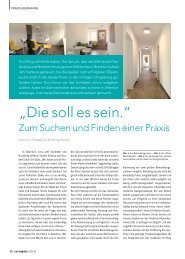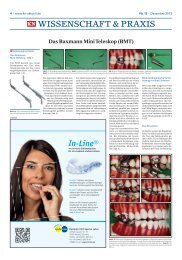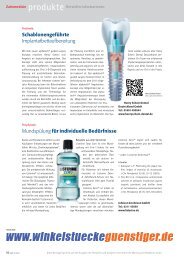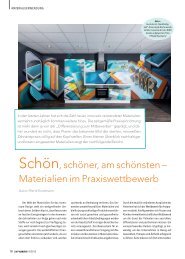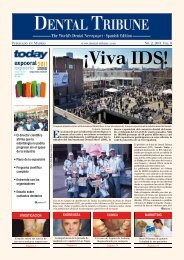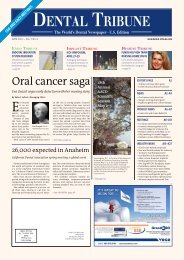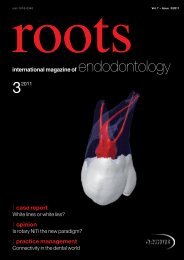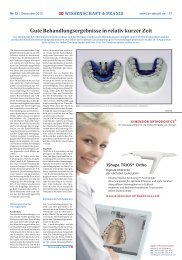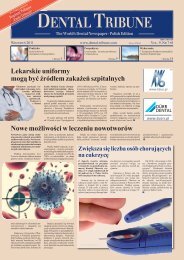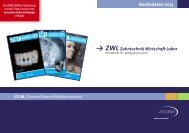Download - Oemus Media AG
Download - Oemus Media AG
Download - Oemus Media AG
Create successful ePaper yourself
Turn your PDF publications into a flip-book with our unique Google optimized e-Paper software.
DeNtal tribuNe | april-June, 2010 Clinical 19<br />
Case report: Interdisciplinary full mouth rehabilitation<br />
By Dr Ratnadeep Patil, Dr Kripa Shetty, and Dr Kavita Mahesh, India<br />
Introduction<br />
The success of functional and<br />
esthetic restorations in a case<br />
requiring full mouth rehabilitation<br />
is often dependant on<br />
our understanding of interdisciplinary<br />
concepts. With every<br />
patient being unique and representing<br />
a special blend of age,<br />
personality characteristics as<br />
well as expectations, our knowledge<br />
of interdisciplinary concepts<br />
can open a whole range<br />
of treatment options and outcomes.<br />
1 Today, every dental<br />
practitioner must have a thorough<br />
knowledge of the roles<br />
of these disciplines in producing<br />
an esthetic makeover, with the<br />
most conservative and biologically-sound<br />
interdisciplinary<br />
treatment plan. 2,3<br />
Case Report<br />
A 57-year-old female patient<br />
reported with the complaint of<br />
mobile teeth, spacing in anterior<br />
dentition, missing bridge, and<br />
desire to restore her smile.<br />
During clinical examination,<br />
it was noted that the patient<br />
had deep periodontal pockets,<br />
missing teeth, mobile and migrated<br />
teeth. Diagnostic periapical<br />
radiograph revealed horizontal<br />
bone loss and missing<br />
teeth. Based on the clinical<br />
and radiographical evidence,<br />
it was diagnosed that the patient<br />
was suffering from generalized<br />
moderate periodontitis with<br />
trauma from occlusion. The<br />
treatment plan was made keeping<br />
in mind the end-result,<br />
harmonious with biological<br />
and functional aspects. The<br />
treatment plan involved:<br />
- Periodontal therapy involving<br />
subgingival curettage.<br />
- Extraction of hopeless teeth.<br />
- Crowns and bridges on<br />
remaining teeth, along with<br />
implant-supported prosthesis<br />
for missing teeth. Rehabilitation<br />
of occlusion is the<br />
crucial phase to ensure longterm<br />
oral health.<br />
- Intentional root canal treatment<br />
was performed for<br />
remaining teeth in order<br />
to alleviate post-periodontal<br />
therapy hypersensitivity.<br />
- Maintenance and recall.<br />
Material options were given<br />
to the patient and a metal<br />
ceramic prosthesis was chosen.<br />
Treatment Sequencing<br />
Treatment was carried out in<br />
the mandibular arch followed<br />
by the maxillary arch in the<br />
following phases:<br />
Phase 1<br />
Subgingival curettage of the<br />
lower arch along with the<br />
extraction of lower right (LR)<br />
1 and 2, and lower left (LL)<br />
1, 2, and 7, followed by placement<br />
of immediate extraction<br />
implants (Xive/Frialit by Friadent,<br />
GmBH) on LR 6(4.5 x 13),<br />
2(3.4 x13) and LL 2(3.4 x 13),<br />
7(5.5 x 8) was done. Prefabricated<br />
provisional acrylic fixed<br />
prostheses were given in the<br />
same sitting resting on the<br />
remaining natural teeth. Occlusal<br />
adjustments were made<br />
to achieve proper function,<br />
comfort, and esthetics.<br />
After a week, subgingival<br />
curettage of the upper arch<br />
along with extraction of upper<br />
right (UR) 1, 2, 4, 5, and 6, and<br />
Upper left (UL) 1, 2, 4, and 6<br />
followed by immediate extraction<br />
implants (Xive/Frialit by<br />
Friadent, GmBH) on UR 2<br />
(3.4 x 11), 4(3.8 x 13), 5(3.8 x 11),<br />
6(4.5 x 9.5); UL 1(3.8 x 11),<br />
2(3.4 x 11), 4(3.8 x 13), 6(4.5<br />
x 8) was done. Prefabricated<br />
provisional acrylic fixed prostheses<br />
were given after bite<br />
adjustment. During the following<br />
visit, intentional root canal<br />
treatment was performed in<br />
LR 3, 4, 5, 7, and LL 3, 4, 5, 6<br />
teeth.<br />
Phase 2<br />
The loading of abutment in the<br />
upper and lower arch implants<br />
was performed six months after<br />
the stage 1 surgery. UL 3 was,<br />
also extracted due to persisting<br />
mobility, hence, poor long-term<br />
prognosis. Intentional root canal<br />
treatment was performed in UR<br />
3, 7 and UL 5, 7 to improve<br />
their prognosis and prepared<br />
to receive crowns.<br />
After a week, final impressions<br />
were made using rubber<br />
base impression material, and<br />
working casts were prepared<br />
to make abutments. The working<br />
casts were then mounted<br />
on a non-arcon, semi-adjustable<br />
articulator using facebow<br />
records. The centric relation<br />
and vertical dimension were<br />
also transferred to the articulator<br />
from the patient, using<br />
polyvinyl siloxane putty bite.<br />
During metal trial, fit of the<br />
castings and occlusal clearance<br />
were checked. A Bisque trial<br />
was, done to confirm fit, shade<br />
and occlusal parameters.<br />
Later, the final metal ceramic<br />
prosthesis was constructed. The<br />
final prosthesis, after all occlusal<br />
adjustment, was cemented<br />
using Glass Ionomer Cement.<br />
Recall appointments were given<br />
for cleaning and maintenance<br />
of the prostheses at every 6<br />
months.<br />
Restorative and Occlusal<br />
Consideraions<br />
The final occlusion given to<br />
the patient was Class II with<br />
anterior guidance, which<br />
1a 1b 1c 1d<br />
Figs. 1a-d: Pre-operative intra oral view<br />
1e 1f 2a<br />
Fig. 1e: Pre-operative smile Fig. 1f : Pre-operative OPG Fig. 2a: Maxillary occlusal view after final preparation<br />
2b 2c 3a<br />
Fig. 2b: Mandibular occlusal view after final preparation Fig. 2c: Post-loading OPG Fig. 3a:Post-operative intraoral view<br />
3b 3c 3d 3e<br />
Figs. 3b-d: Post-operative intraoral view<br />
Fig. 3e: Post-operative smile



